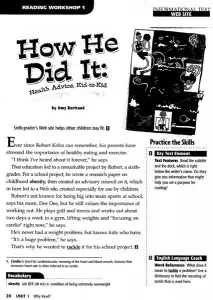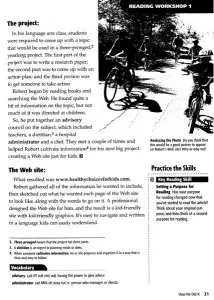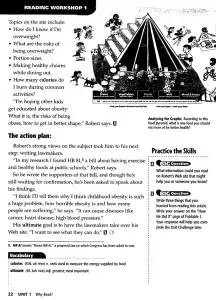Planning a literacy lesson using the four resource model
1. Introduction
The purpose of this article is to map out plans for a literacy lesson using the framework articulated by Freebody and Luke (1999a) in the four resources model. The reason why I have chosen to write about the practicalities of the four resources model lies in the fact that literacy is an important contemporary topic, especially in the context of middle school students. Rush (2004) noticed that research mainly focuses on reading intervention in the early years of schooling, while middle school students are a neglected target group. This paper aims to curb this situation. At the same time, the present paper aims to put into practice Freebody and Luke’s four resources model, thus creating a much needed precedent in middle school literacy education.
The paper is structured into three parts. The first part deals with a literature review of the four resources model with the focus on the four main roles (i.e., code breaker, meaning maker, text user, and text analysis). The second part of the paper presents the literacy lesson under analysis and the educational standards that have to be met according to the school curriculum. The third part maps out plans for the chosen lesson, giving examples of activities for each of the four main roles in Freebody and Luke’s four resources model. The paper ends with a conclusion, followed by a relevant list of references.
Key words: curriculum, Freebody and Luke, four resource model, literacy, lesson, standards
2. Literature review
The definition of literacy in the twenty-first century as stated in Literate Futures: Report of the literacy review for Queensland state schools is a broad one: “Literacy is the flexible and sustainable mastery of a repertoire of practices with texts of traditional and new communication technologies via spoken language, print and multi media” (Luke, Freebody and Land, 2000, p.9). At the same time, Freebody and Luke (1999b) argue that literacy education does not mean developing certain skills but, as suggested in the definition above, it refers to developing social, cultural, and economic practices.
According to the four resources model framework, the repertoire of literacy practices has been separated by Freebody and Luke (1999a) into four main roles. Luke and Freebody decided to conceptualise literacy in this way because they realised that everyone – regardless of their view of literacy – was (practically) right. The four resources model focuses on the range of practices which, if emphasized in a reading program, will be able to cover and integrate a repertoire of textual practices needed in today’s new economies and cultures (Freebody and Luke, 1999a). Literate Futures also acknowledges the fact that effective progress in schoolwork was highly influenced by the acquisition of reading (Luke, Freebody and Land, 2000).
The four resources model does not discard the current and well-developed techniques used by teachers worldwide to train their students in becoming literate, but rather attempts to recognize and incorporate them. As such, the model became a map of possible practices dependent on the teacher’s reading of his or her students’ existing linguistic, cultural, and textual practices (Freebody and Luke, 1999a). The four resources model is a framework that “avoids a model of literacy as the artifact of pedagogical styles or preferences; rather it draws attention to the kinds of practices students need to learn” (Comber, 1997, p. 32).
The creators of the four resources model did not have the intention of transforming their model into a solution to all literacy problems, but rather, Freebody and Luke offered an alternative way to teaching the skill of reading and a way of conceptualising what (effective) readers do. This is also evident from their decision to change the terminology used since the model’s initial development, preferring to use the notion “practices” instead of “roles.” The word “practices” even suggests that the models are applied in everyday classroom or community contexts. On the contrary, the term “role” suggested a pre-established framework that students need to fit into (Freebody and Luke, 1999a).
According to Freebody and Luke (1999a), literacy has three dimensions: breadth, depth, and extent. The breadth of an individual’s or community’s repertoire of literate practices refers to the range of social activities offered by the curriculum. These literacy activities are also referred to by different researchers as “genres” or “text types.” The concept of extent refers to the range of novelty, transformation, and redesign at work.
Both the breadth and depth of literacy practices can be assessed because they are developed though educational experiences (Freebody and Luke, 1999b). The depth of skills exercised by a student draws on a repertoire of literacy practices that allows the learner to successfully engage in reading and writing activities. Of course, literacy can also include listening and speaking, as well as multimedia texts. The four practices advocated by Freebody and Luke’s model are: (1) breaking the code of texts, (2) participating in the meanings of text, (3) using texts functionally, and (4) critically analysing and transforming texts (Freebody and Luke, 1999a).
The reader as a code breaker refers to the ability of a person to successfully recognize and engage the technology of written texts (Freebody, 1992), with an emphasis on decoding and encoding the symbols of written, spoken, and visual texts. This includes the alphabet, sounds in words, whole words, letter/sound relationship; spelling; grammar, vocabulary, punctuation, intonation, rhythm; clauses, sentences, and text structure; and visual, nonverbal, and auditory codes (Ludwig, 2003).
The reader as a meaning maker or text participant entails engaging the technology of the text itself (Freebody, 1992) by comprehending and making meaning from written and spoken texts. This includes using background knowledge to construct meaning; comparing personal experiences with the ones presented in texts; relating previous experiences with similar texts; seeing own interests and lifestyles reflected in texts; interpreting words, clauses, sentences, and texts; interpreting visual, nonverbal, and auditory texts; and looking at the way texts are constructed to make a specific meaning (Ludwig, 2003).
The reader as a text user means being able to take part in social activities in which the written text plays a major part (Freebody, 1992), with an emphasis on knowing how to use texts – appropriate audience and purpose, the right type of text for the right context and purpose. This includes understanding cultural and social contexts which dictate the way texts are structured; using appropriate text types for specific purposes; recognising the particular structures and features of texts; and understanding the options for using certain texts to convey particular meanings (Ludwig, 2003).
The reader as a text critic or text analyst refers to the understanding that written, spoken, and visual texts are not neutral, no matter how factual or neutral the texts seem to appear (Freebody, 1992). Most texts rather advocate particular points of view while silencing others. This includes recognising the purpose in creating the text; recognising that texts influence people; recognising opinions, bias, points of view, and missing points of view in the text; understanding that texts are written according to the views and interests of the author; identifying the ways in which the readers, viewers, or listeners are influenced; and presenting alternative points of view (Ludwig, 2003).
Freebody and Luke (1999b) argue that the practices presented in the four resources model are necessary, but none of the four areas are sufficient to become effective literate citizens. It is also believed that the four resources model produces different learning effects for different groups of students, depending on the pedagogies and curricula used.
3. The text under analysis
The four resources model has been used effectively by teachers worldwide in mapping the strengths of students, with a focus on strategies aimed at developing the students’ weaknesses (Further notes on the four resources model: Transcript of one conversation with the authors, 1999). Teachers also believe that Freebody and Luke’s model provides a framework for well rounded instructions in classrooms (Rush, 2004).
The target text that will be incorporated in the four resources framework is entitled “How He Did It: Health Advice, Kid-to-Kid” by Amy Bertrand, part of Unit 1. Why read? in Glencoe Literature. Reading with purpose by Jeffrey D. Wilhelm et al. (2007). According to the English-language arts content standards for California public schools, kindergarten through grade twelve, the standards that apply to this lesson are:
– Under “READING: Word Analysis, Fluency, and Systematic Vocabulary Development,” the students should be able to “1.3. Clarify word meanings through the use of definition, example, restatement, or contrast” (California Department of Education, 1998, p.42);
– Under “READING: Reading Comprehension (Focus on Informational Materials),” the students should be able to “2.4. Identify and trace the development of an author’s argument, point of view, or perspective in text” (California Department of Education, 1998, p.43) and “2.6. Assess the adequacy, accuracy, and appropriateness of the author’s evidence to support claims and assertions, noting instances of bias and stereotyping” (p.43);
– Under “WRITING: Writing Strategies,” the students should be able to “1.1. Create an organizational structure that balances all aspects of the composition and uses effective transitions between sentences to unify important ideas” (California Department of Education, 1998, p.44);
4. Mapping out plans
According to Freebody (1992), a successful reader needs to develop and be able to sustain the resources needed to play the four roles of the model: code-breaker (“How do I crack this?”), text-participant (“What does this mean?”), text-user (“What do I do with this, here and now?”), and text-analyst (“What does this do to me?”).
In this section, the four resources model will be used as an instructional framework to map out plans for teaching a reading lesson using How He Did It: Health Advice, Kid-to-Kid by Amy Bertrand. Following are examples of how the text under analysis can be used within each of the four areas of the framework will be given. All the activities suggested below have been designed for a class of 12, Grade 7 students, but are easily applicable to other middle school levels. The students are assigned How He Did It: Health Advice, Kid-to-Kid (Bertrand, 2007) and divided into four groups of three. One student in each group is chosen to represent the group and to record the group’s findings and, later on, share them with the other groups.
The question that each group will have to explore in order to develop code breaking strategies is: “Which words do you think are interesting?” (Learning Role Cards, 2002). In their groups, the students brainstorm ideas and the group representative writes down the words that appeal to them. Once they have completed this task, the teacher asks the students to give an explanation of what the words mean in their contexts. The representatives take notes once again. While the students are on task, the teacher monitors and gives advice and assistance where needed. After the students have completed the activity, the representatives of each group share their ideas with the other groups. Once back in their original groups, the entire class helps to put up a list of interesting words found in the text under analysis. This list can be used later on by the teacher as the weekly spelling list. This activity meets standard 1.3 under “Word Analysis, Fluency, and Systematic Vocabulary Development” (California Department of Education, 1998).
The question that each group will have to explore in order to develop meaning making strategies is: “What are the main ideas presented?” (Learning Role Cards, 2002). Each group is given the possibility of choosing one idea that they would like to analyse in terms of the author’s argument, point of view, or perspective in text. After the students have completed the task, the representatives of each group present their findings in front of the class. With visual support from the book, the presentations can generate lively discussions in which the teacher can take the role of facilitator and mediator. This activity meets standard 2.4 under “Reading Comprehension (Focus on Informational Materials)” (California Department of Education, 1998).
The question that each group will have to explore in order to develop text using strategies is: “If you were to make your own version of a website about the topic under discussion, how would it be different to the print version?” (Learning Role Cards, 2002). The students create an organizational structure for their website, balancing all aspects of the composition. In order to unify important ideas, the students are asked to uses effective transitions between sentences and prepare the virtual links of each section of their web site. The teacher can collaborate with the Information Technology teacher so that the students brainstorm for ideas in the class, and create their web sites in the computer room. This activity meets standard 1.1 under “WRITING: Writing Strategies” (California Department of Education, 1998).
The four questions that each group will have to explore in order to develop text analysing strategies are: “Are there stereotypes in the text? Who does the text favour or represent? Who does the text reject or silence? How does this text claim authority?” (Learning Role Cards, 2002). On completion, each group reports back to the class, supporting their answers with examples for the text. This activity meets standard 2.6 under “Reading Comprehension (Focus on Informational Materials)” (California Department of Education, 1998).
5. Conclusion
This paper has presented the main characteristics of the four resources model, giving detailed explanations of what Freebody and Luke (1999a) understand by code breaker, meaning maker, test user, and text analyst. In order to connect theory to classroom practice, a text had been chosen and activities that match the four resources framework had been presented. The author of this essay believes, just as other researchers have concluded (see Rush, 2004), that the four resources model advocated by Freebody and Luke (1999a) can be used to develop a range of skills and knowledge needed by all literacy learners.
References
- Bertrand, A. (2007). How He Did It: Health Advice, Kid-to-Kid. In Wilhelm, J.D., et al., Glencoe Literature. Reading with purpose. Columbus: Glencoe/McGraw-Hill.
- California Department of Education. (1998) English-language arts content standards for California public schools, kindergarten through grade twelve.
- Comber, B. (1997). Literacy, poverty and schooling: working against deficit equations, English in Australia, no. 119/120, pp.22-34.
- Freebody, P. (1992). A socio-cultural approach: resourcing four roles as a literacy learner. In A. Watson & A. Badenhop (Eds.). Prevention of Reading Failure. Gosford: Ashton Scholastic.
- Freebody, P., and Luke A. (1999a). A map of possible practices: Further notes on the four resources model. Practically Primary, 4 (2), pp.5-8.
- Freebody, P., and Luke A. (1999b). Further notes on the four resources model.
- Further notes on the four resources model: Transcript of one conversation with the authors (October 26, 1999).
- Learning Role Cards (2002).
- Ludwig, C. (2003). Making sense of literacy. Newsletter of the Australian Literacy Educators’ Association.
- Luke, A., Freebody, P., & Land, R. (2000). Literate Futures: Report of the literacy review for Queensland state schools. Brisbane, Australia: Education Queensland.
- Rush, L.S. (2004). First steps towards a full and flexible literacy: Case studies of the Four Resources Model. Reading Research and Instruction, 43 (3), pp. 37-55.
- Wilhelm, J.D., Fisher., D., Hinchman, K.A., O’Brien, D., Raphel, T. & Shanahan, C.H. (2007). Glencoe Literature. Reading with purpose. Columbus: Glencoe/McGraw-Hill.
Originally published in “Journal Plus Education,” Vol. VIII (2012), No. 1, pp. 232-40




